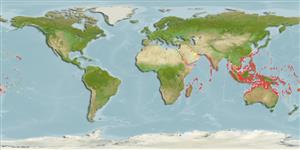Common names from other countries
>
Acanthuriformes (Surgeonfishes) >
Acanthuridae (Surgeonfishes, tangs, unicornfishes) > Acanthurinae
Etymology: Paracanthurus: Greek, para = the side of + Greek, akantha = thorn + Greek, oura = tail (Ref. 45335).
More on author: Linnaeus.
Environment: milieu / climate zone / depth range / distribution range
Ecologia
marinhas associadas(os) a recifes; intervalo de profundidade 2 - 40 m (Ref. 1602), usually 10 - 40 m (Ref. 27115). Tropical; 30°N - 30°S, 32°E - 170°W
Indo-Pacific: East Africa, including the Mascarene Islands (Ref. 37792) to Kiribati, north to southern Japan, south to the southern Great Barrier Reef, New Caledonia, and Samoa.
Tamanho / Peso / Idade
Maturity: Lm ? range ? - ? cm
Max length : 31.0 cm TL macho/indeterminado; (Ref. 2334)
Descrição suscinta
Chaves de identificação | Morfologia | Morfometria
Espinhos dorsais (total) : 9; Raios dorsais (total) : 19 - 20; Espinhos anais: 3; Raios anais : 18 - 19.
Occur in clear, current-swept terraces of seaward reefs. Observed in loose aggregations 1 or 2 meters above the bottom; juveniles and subadults typical in groups near isolated Pocillopora eydouxi coral heads and when alarmed hide themselves tightly among the branches (Ref. 9710). Benthopelagic (Ref. 58302). Feed on zooplankton and occasionally on algae (Ref. 9710, 48637, 27115, 83665). Relatively uncommon and highly localized (Ref. 1602, 9710). Very popular and hardy aquarium fish. Anterolateral glandular groove with venom gland (Ref. 57406).
Ciclo de vida ou comportamento de acasalamento
Maturities | Reprodução | Spawnings | Egg(s) | Fecundities | Larvas
Myers, R.F., 1991. Micronesian reef fishes. Second Ed. Coral Graphics, Barrigada, Guam. 298 p. (Ref. 1602)
Status na Lista Vermelha da UICN (Ref. 130435)
CITES (Ref. 128078)
Not Evaluated
Uso pelos humanos
Pescarias: espécies comerciais; Aquário: Espécies comerciais
Ferramentas
Relatórios especiais
Baixar XML
Fontes da internet
Estimates based on models
Preferred temperature (Ref.
115969): 24.7 - 29, mean 27.9 (based on 1082 cells).
Índice de diversidade filogenética (Ref.
82804): PD
50 = 1.0000 [Uniqueness, from 0.5 = low to 2.0 = high].
Bayesian length-weight: a=0.02344 (0.01098 - 0.05004), b=2.97 (2.80 - 3.14), in cm Total Length, based on LWR estimates for this (Sub)family-body shape (Ref.
93245).
Nível Trófico (Ref.
69278): 3.4 ±0.45 se; based on food items.
Resiliência (Ref.
120179): Elevada, tempo mínimo de duplicação da população menor que 15 meses (Preliminary K or Fecundity.).
Fishing Vulnerability (Ref.
59153): Low vulnerability (21 of 100).
